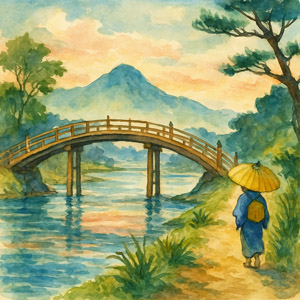— Japanese Proverb
 The art form Ukiyo-e, “pictures of the floating world,” was named after the Buddhist belief of transience and life's fleeting joy.
The art form Ukiyo-e, “pictures of the floating world,” was named after the Buddhist belief of transience and life's fleeting joy.
Popular in the 17th–19th century, when Japan was ruled by the shoguns and isolated from the rest of the world, Ukiyo-e captured life's common pleasures. The beautiful prints were created from woodblocks called ukiyo-e (“oo-kee-oh-eh”).
The art form's most famous artist, Ando Hiroshige (1797–1858) was born in Edo (now Tokyo) and called “the artist of rain, snow, and mist” for his landscapes.
Just as the Japanese proverb reminds us, “Who travels for love finds a thousand miles not longer than one,” Hiroshige sketched for love of his countryside. His collection of prints, Fifty-Three Stations of the Tokaido Road (1834), was the era's masterpiece. Inspired by the historic 500-kilometer trip along the Tokaido Highway from Edo to Kyoto, Hiroshige's sketches integrated outdoor scenes with ordinary people and animals.
The poet-philosopher Matsuo Basho once described such simple pleasure as:
“Long conversations beside blooming irises
joys of life on the road.”
In his lifetime, Hiroshige completed over 5,400 illustrations, prints, and paintings. His work was popular for its innovative use of colors, its vitality, and celebration of nature, which inspired Van Gogh, Monet, and other impressionist painters.
“Art,” observed philosopher Susanne K. Langer, “is the objectification of feeling and the subjectification of nature.”

 Use the
Use the